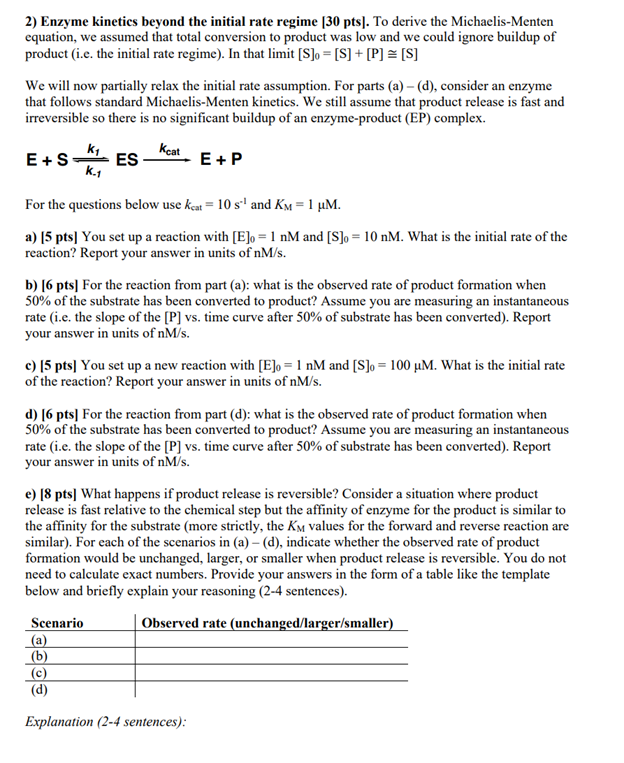Answered step by step
Verified Expert Solution
Question
1 Approved Answer
Please provide detail answers to all questions. Thanks! 2) Enzyme kinetics beyond the initial rate regime [30 pts]. To derive the Michaelis-Menten equation, we assumed

Please provide detail answers to all questions. Thanks!
2) Enzyme kinetics beyond the initial rate regime [30 pts]. To derive the Michaelis-Menten equation, we assumed that total conversion to product was low and we could ignore buildup of product (i.e. the initial rate regime). In that limit [S]0=[S]+[P][S] We will now partially relax the initial rate assumption. For parts (a) - (d), consider an enzyme that follows standard Michaelis-Menten kinetics. We still assume that product release is fast and irreversible so there is no significant buildup of an enzyme-product (EP) complex. E+Sk1k1ESkcatE+P For the questions below use kcat=10s1 and KM=1M. a) [5 pts] You set up a reaction with [E]0=1nM and [S]0=10nM. What is the initial rate of the reaction? Report your answer in units of nM/s. b) [6 pts] For the reaction from part (a): what is the observed rate of product formation when 50% of the substrate has been converted to product? Assume you are measuring an instantaneous rate (i.e. the slope of the [P] vs. time curve after 50% of substrate has been converted). Report your answer in units of nM/s. c) [5 pts] You set up a new reaction with [E]0=1nM and [S]0=100M. What is the initial rate of the reaction? Report your answer in units of nM/s. d) [6 pts] For the reaction from part (d): what is the observed rate of product formation when 50% of the substrate has been converted to product? Assume you are measuring an instantaneous rate (i.e. the slope of the [P] vs. time curve after 50% of substrate has been converted). Report your answer in units of nM/s. e) [8 pts] What happens if product release is reversible? Consider a situation where product release is fast relative to the chemical step but the affinity of enzyme for the product is similar to the affinity for the substrate (more strictly, the KM values for the forward and reverse reaction are similar). For each of the scenarios in (a) - (d), indicate whether the observed rate of product formation would be unchanged, larger, or smaller when product release is reversible. You do not need to calculate exact numbers. Provide your answers in the form of a table like the template below and briefly explain your reasoning ( 24 sentences). Explanation (2-4 sentences)Step by Step Solution
There are 3 Steps involved in it
Step: 1

Get Instant Access to Expert-Tailored Solutions
See step-by-step solutions with expert insights and AI powered tools for academic success
Step: 2

Step: 3

Ace Your Homework with AI
Get the answers you need in no time with our AI-driven, step-by-step assistance
Get Started


